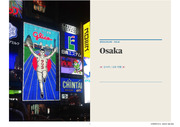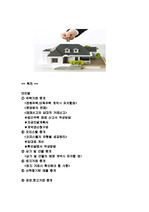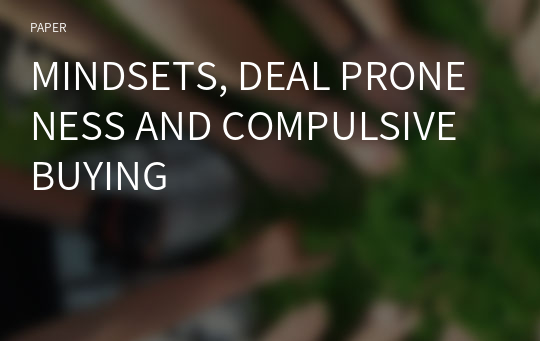MINDSETS, DEAL PRONENESS AND COMPULSIVE BUYING
* 본 문서는 배포용으로 복사 및 편집이 불가합니다.
서지정보
ㆍ발행기관 : 글로벌지식마케팅경영학회(GFMC)
ㆍ수록지정보 : Global Marketing Conference
ㆍ저자명 : Arnold Japutra, Zening Song, Ahmad Daryanto
ㆍ저자명 : Arnold Japutra, Zening Song, Ahmad Daryanto
영어 초록
IntroductionCompulsive buying refers to a condition where consumers make purchases repetitively and excessively (Ridgway, Kukar-Kinney & Monroe, 2008; Japutra, Ekinci & Simkin, 2017). Previous literature shows that two types of behaviors characterize compulsive buying: impulsive buying and obsessive-compulsive buying (Ridgeway et al, 2008). Impulsive buying refers to unplanned purchase due to consumers’ inevitable impulse (Kacen & Lee, 2002), and obsessive-compulsive buying reflects a preoccupation in buying to reduce anxiety (Ridgway et al, 2008). Compulsive buying behaviors have been analyzed under the framework of motivation theory (McGuire, 1976). Nevertheless, research is still needed to understand more on the phenomena of compulsive buying (e.g., Kukkar-Kinney et al., 2016; Japutra et al., 2017). This study aims to explore the antecedents of compulsive buying behaviors using implicit theories. According to the implicit theories, mindset shapes the motivation of consumer behaviors (Dweck, 2000; Murphy & Dweck, 2016). Mindset refers to the beliefs about the nature of human characteristics, and individuals may possess two types of mindset – fixed and growth mindset (Murphy & Dweck, 2016). People with a fixed mindset believe that individuals’ qualities such as intelligence and competence are set and hard to change, whereas those with a growth mindset tend to believe that all individuals are able to change and develop through efforts and experiences. We argue that mindsets influence compulsive buying, and we propose that deal proneness mediates the relationship between mindset and compulsive buying. In doing so, we aim to enhance our knowledge in understanding how mindset affects compulsive buying behavior.
Literature review and hypotheses
According to the implicit theories, consumers with fixed mindsets believe that one’s abilities are fixed and hard to improve, and thus feel the need to prove, to themselves and others, that they have the abilities and/or they are successful (Murphy & Dweck, 2016). Thus, fixed mindset consumers tend to demonstrate their worth by using image-enhancing products and brands (Park & John, 2012). Deals, such as free gifts and offer of coupons, reduce the transaction cost and increase the perceived value of these image-enhancing purchases. In particular, since fixed mindset consumers favor success with little effort (Murphy and Dweck, 2016), deals can help them achieve their goal of image enhancement with lower cost. Thus, we hypothesize that: H1 Fixed mindset is positively related to deal proneness. For consumers with growth mindsets, a major motivation for their consumer behavior is to learn and improve (Murphy & Dweck, 2016). As the research by Blackwell et al. (2007) shows, growth mindset consumers are eager to participate in the self-improving process and achieve mastery. Thus, growth mindset consumers may perceive the information of discounts, free gifts and coupons as part of the adventurous process where they make the cost-benefit analysis and improve their abilities as wiser consumers. Thus, we propose: H2 Growth mindset is positively related to deal proneness. Previous studies show that compulsive buying is associated with high deal proneness (Kukar-Kinney et al, 2012). Deals may imply perceived value of the purchase and enhanced shopping enjoyment (Grewal, Monroe, & Krishnan, 1998), and thus serve as an effective contextual factor in inducing compulsive behaviors (Kukar-Kinney et al, 2016). Furthermore, deals provide an excuse and rationale for the purchase, which can be used to overcome the sense of guilt compulsive buyers often experience after their compulsive buying behavior (O’Guinn & Faber, 1989). Thus, we make the following hypotheses. H3 Deal proneness is positively related to impulsive buying. H4 Deal proneness is positively related to obsessive-compulsive buying. Finally, we argue that deal proneness mediates the relationship between consumer mindsets and compulsive buying behavior. According to the implicit theories, consumer mindsets inspire how consumption goals are pursued (Murphy & Dweck, 2016). Consumers with a fixed mindset pursue a performance goal, and they tend to use brands to feel positive about themselves and improve impression on others (Park & John, 2010). In contrast, consumers with a growth mindset hold that people can always learn and improve and thus are tuned to learning goals (Murphy & Dweck, 2016). Hence, for fixed mindset consumers, deal offers suggest lower costs for image-enhancing purchases, and provide an excuse for the compulsive buying behavior. For growth mindset consumers, deal offers can imply a learning and adventurous process .These consumers may feel that they can make better purchasing decisions by taking advantage of various deals. We thus hypothesize that: H5 Deal proneness mediates the relationship between fixed mindset and impulsive buying (H5a), between fixed mindset and obsessive-compulsive buying (H5b), between growth mindset and impulsive buying (H5c), and between growth mindset and obsessive-compulsive buying (H5d).
Method
A questionnaire was developed to gather responses and test the hypotheses. All of the items to measure the constructs were developed from existing scales based on previous research. Fixed and growth mindsets were measured using scales developed by Park and John (2012). Deal proneness was measured using items following Lichtenstein et al. (1997). Impulsive buying and obsessive-compulsive buying were measured using items developed by Ridgway et al. (2008). All items were rated on a 7-point Likert scale, ranging from “strongly disagree” (1) to “strongly agree” (7). The questionnaire was administered using an online survey (N=421 respondents). Of these, 57.7% were female, 71.5% had a university degree, 50% were 31-40 years old, 41% were 26-30 years old, and 46.3% had a monthly income of 5,001-10,000 RMB.
Results and discussion
To test the hypotheses within the research model, a Structural Equation Modeling (SEM) approach was employed, using AMOS 18.0. First, a measurement model was created to assess the validity and reliability of the scales. The distribution of the data was checked. The absolute value of the skewness and kurtosis of each items were within +/- 1, suggesting normal distribution was achieved. The measurement model produced good fit (Hair et al., 2010): χ2(109) = 281.21, χ2/df = 2.58, GFI = .93, NFI = .93, CFI = .96, and RMSEA = .06. All values representing the AVE were greater than 0.5 and greater than the squared inter-constructs correlations, indicating convergent and discriminant validity were achieved (Fornell & Larcker, 1981). Cronbach’s alpha values exceeded .70, indicating the constructs were reliable (Hair et al., 1995). The results of the checking common-method variance problem through exploratory factor analysis (EFA) test revealed 3 factors with Eigen values greater than 1. The results accounted for 64.67% of the total variance, where the first factor accounted for 27.55% of the total variance, suggesting that common-method variance did not pose a significant problem since there was no general factor in the un-rotated structure (Podsakoff et al., 2003). Next, a structural model was created. The structural model produced good fit (Hair et al., 2010): χ2(114) = 476.15, χ2/df = 4.18, GFI = .89, NFI = .89, CFI = .91, and RMSEA = .09. Table 1 displays the results of SEM. The results support H1 and H2. Both fixed and growth mindsets are positively associated with deal proneness. The results support H3 and H4, which shows that deal proneness are positively associated with impulsive and obsessive-compulsive buying. The results support H5a, which states that deal proneness mediates the relationship between fixed mindset and impulsive buying. However, the results do not support H5b, H5c and H5d.
Conclusion
Using the implicit theories, this research aims to gain better insight into compulsive buying behavior. Our findings, obtained from a sample of respondents in China, show that deal proneness serves as a mediator between fixed mindset and compulsive buying behaviors. According to the implicit theories, consumer mindsets inspire how consumption goals are pursued (Murphy & Dweck, 2016). For instance, consumers with a fixed mindset pursue a performance goal. They tend to use brands to feel positive about themselves and improve impression on others (Park & John, 2010). Thus, it is likely that fixed mindset consumers buy compulsively to signal and communicate their “self” to others. In particular, for fixed mindset consumers, deals may increase the perceived value of image-enhancing purchases. Thus, deals provide an excuse for the compulsive purchase where fixed mindset consumers can improve self-image and demonstrate their worth with lower costs. Given this mediating role of deal proneness between fixed mindset and compulsive buying, it will be interesting to test further how consumers with a fixed mindset respond to different types of deals in future research. For firm managers and public policy makers, our findings imply that, to lessen consumers’ overspending, firms should reduce excessive number of deals, and governments should also regulate firms’ advertisement so that it will not overly promote deals.
참고 자료
없음태그
"Global Marketing Conference"의 다른 논문
 THE ROLES OF GREEN PACKAGING IN UGLY FOOD PURCHASE INTE..22페이지
THE ROLES OF GREEN PACKAGING IN UGLY FOOD PURCHASE INTE..22페이지 THE IMPACT OF INDUCED AWE ON ETHICAL TOURIST BEHAVIORS5페이지
THE IMPACT OF INDUCED AWE ON ETHICAL TOURIST BEHAVIORS5페이지 A BIBLIOMETRIC ANALYSIS OF SPIRITUAL TOURISM RESEARCH15페이지
A BIBLIOMETRIC ANALYSIS OF SPIRITUAL TOURISM RESEARCH15페이지 SOCIAL NETWORK ANALYSIS AND RESPONSE TIME TESTING: CONS..11페이지
SOCIAL NETWORK ANALYSIS AND RESPONSE TIME TESTING: CONS..11페이지 THE EFFECTS OF PARA-SOCIAL INTERACTION ON ONLINE CELEBR..3페이지
THE EFFECTS OF PARA-SOCIAL INTERACTION ON ONLINE CELEBR..3페이지 THE INFLUENCE OF OPINION LEADERS ON DAILY DEALS USER’S ..3페이지
THE INFLUENCE OF OPINION LEADERS ON DAILY DEALS USER’S ..3페이지 HOW IMMERSIVE RETAILING AFFECTS CONSUMERS’ URGE TO BUY:..6페이지
HOW IMMERSIVE RETAILING AFFECTS CONSUMERS’ URGE TO BUY:..6페이지 KEY TO SUPERSTARDOM IN A GLOBALISED MARKET: THE ROLE OF..6페이지
KEY TO SUPERSTARDOM IN A GLOBALISED MARKET: THE ROLE OF..6페이지 A POST-PANDEMIC LOOK AT TOURISTS’ PERCEIVED COOLNESS OF..4페이지
A POST-PANDEMIC LOOK AT TOURISTS’ PERCEIVED COOLNESS OF..4페이지 EXTRACTING OFFLINE RETAIL SHOPPING PATTERNS: OLLABORATI..5페이지
EXTRACTING OFFLINE RETAIL SHOPPING PATTERNS: OLLABORATI..5페이지


























